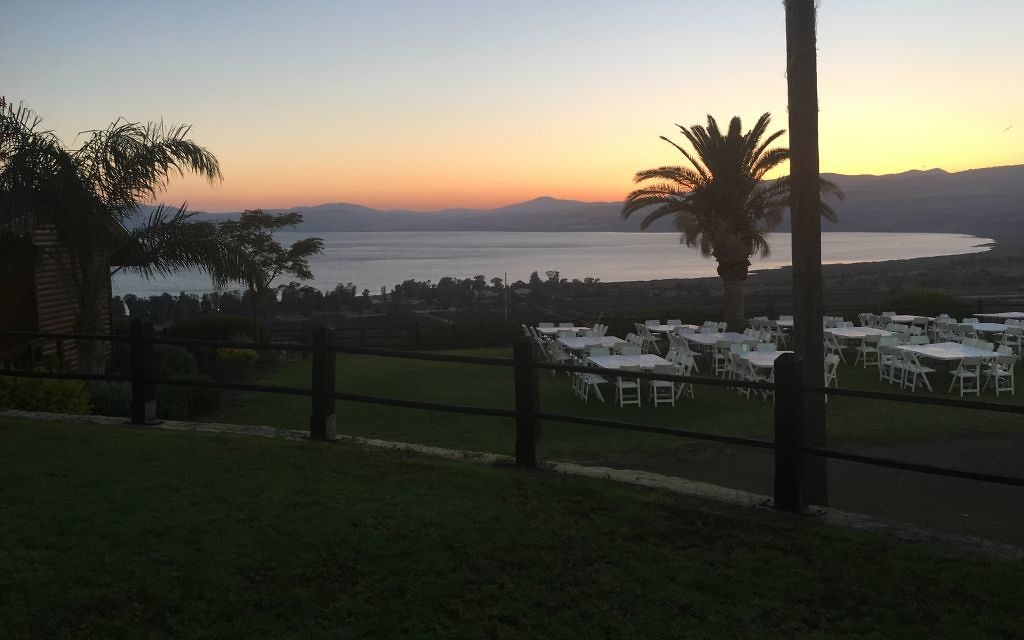Mundell: Israel Is a Beautiful Mess
I was in awe that the Middle East could be so compassionate.
I stepped into the busy baggage claim area with my two small children and my parents and heard words over the intercom in French and then a loud boom.
“Was that gunfire?” I asked my mom.
Armed guards ran by us through the corridor, and we huddled together, not sure what was going on. My worst fear of my Israel trip was actually happening.
Get The AJT Newsletter by email and never miss our top stories Free Sign Up
Except we were in the Paris airport for a 10-hour layover, meeting a tour guide for a quick tour of Paris, and the “threat” was luggage left by itself that the French airport police blew up after announcing in French that it was going to happen.
Our trip literally started out with a bang, and the scariest part of the trip ended up being that moment in Paris, not in Israel.
Israel, to my surprise, wasn’t scary for me at all. It was beautiful.
We kicked off our 10-day tour in Tel Aviv and met our group from Temple Emanu-El, led by Rabbi Spike Anderson. Our trip surprised me and broadened my knowledge and awareness of Israel.
From the beaches of Tel Aviv to mystics of Kabbalah in Tzfat to the rows and rows of crops in the middle of the desert to the Sea of Galilee to the views at Masada and the Golan Heights to the ancient city of Jerusalem, I was amazed to see all the beauty of Israel when I had mainly heard about the fighting and the conflict.
My attempt to share the beauty was translated only in fragments through the camera. Being there at the top of Masada, where our ancestors had been before us, looking out to the Dead Sea and to the valleys below, was breathtaking. Cruising on a boat on the Sea of Galilee was refreshing. Peering out from the top of the Golan was inspiring.
I was in awe that the Middle East could be so beautiful.
And so compassionate and loving.
We met an artist who shared his love of Kabbalah through his art and declared that giving and loving were the higher states of consciousness. We met with Arab children who wanted to understand Jews and the world around them. Who laughed and played games with my own children and talked about wanting to be a doctor and chemist one day.
We also visited Save a Child’s Heart, a nonprofit that provides free cardiac care to children from developing countries who can’t get adequate treatment for heart disease. Most of the children were from Africa, but many were from Israel, the Palestinian Authority, Lebanon and Syria as well.
Lifeline of the Aged, one of our stops in Israel and another nonprofit, provides opportunities for people over 64 years old to learn new artisan skills and work for money, medical care and food. We saw elderly people of all religions making crafts that would later be sold in the gift shop, and they proudly showed us what they each had been working on.
Both of those nonprofits exemplified love for all people.
We spent a few days in Jerusalem exploring the city. As I stood in front of the Western Wall like so many before me and saw thousands of folded little pieces of paper representing hopes, dreams and prayers shoved into every crack and cranny, I felt connected to everyone who had ever visited who had hopes, dreams, burdens, pain and prayers like me.
I saw a wall that showed compassion for all people and a country that allowed all people to pray to their G-d.
At the heart of Israel were beauty, love and compassion.
But I still couldn’t overlook what I knew about the conflict and fighting.
The kibbutz we visited was strategically placed next to the Lebanese border. It added extra security for Israel.

The head of protection for the kibbutz took us to the edge of the kibbutz, where we saw fields of apple trees next to the fence separating Israel from Lebanon. He pointed to a billboard on the other side with a threatening message aimed at him and the Israeli soldiers who guarded the border, calling Israelis’ names and honoring terrorists who had killed people.
I can’t imagine putting my kids to bed next to that every night and walking them to school, knowing what could happen at any moment. We drove up the hill past the crops, and the guide pointed to the preschool, not even a mile from the billboard.
We went to the top of Mount Bental and peered down at a big black cloud coming from the Syrian border. Intense fighting was so close by.
We drove by the Jordanian border, and the tour guide pointed to the location where a group of girls had been gunned down while on a field trip.
All those reminders of danger were lurking around the corner.
One night we learned from a political expert that when the Jews conquered Jerusalem in 1967, they had the opportunity to destroy the Dome of the Rock, the Islamic shrine on the Temple Mount in Jerusalem, as past conquerors had done to the Jewish Temples. But Israel chose not to do that, and a Muslim organization under Jordanian leadership maintains oversight of the Temple Mount.
Destroying the Dome of the Rock would have angered Muslims everywhere, but keeping it intact continues to bring conflict and questions of ownership.
How do you live peacefully next to your enemy? How do you manage (and secure) a city that has multiple owners and religious claims?
It’s complicated and messy. But at least I know now that it’s a beautiful mess.
Temple Emanu-El member Sally Mundell is the founder of the Packaged Good and a mother of two. Read more about the Emanu-El Israel mission in Marita Anderson’s column.







comments